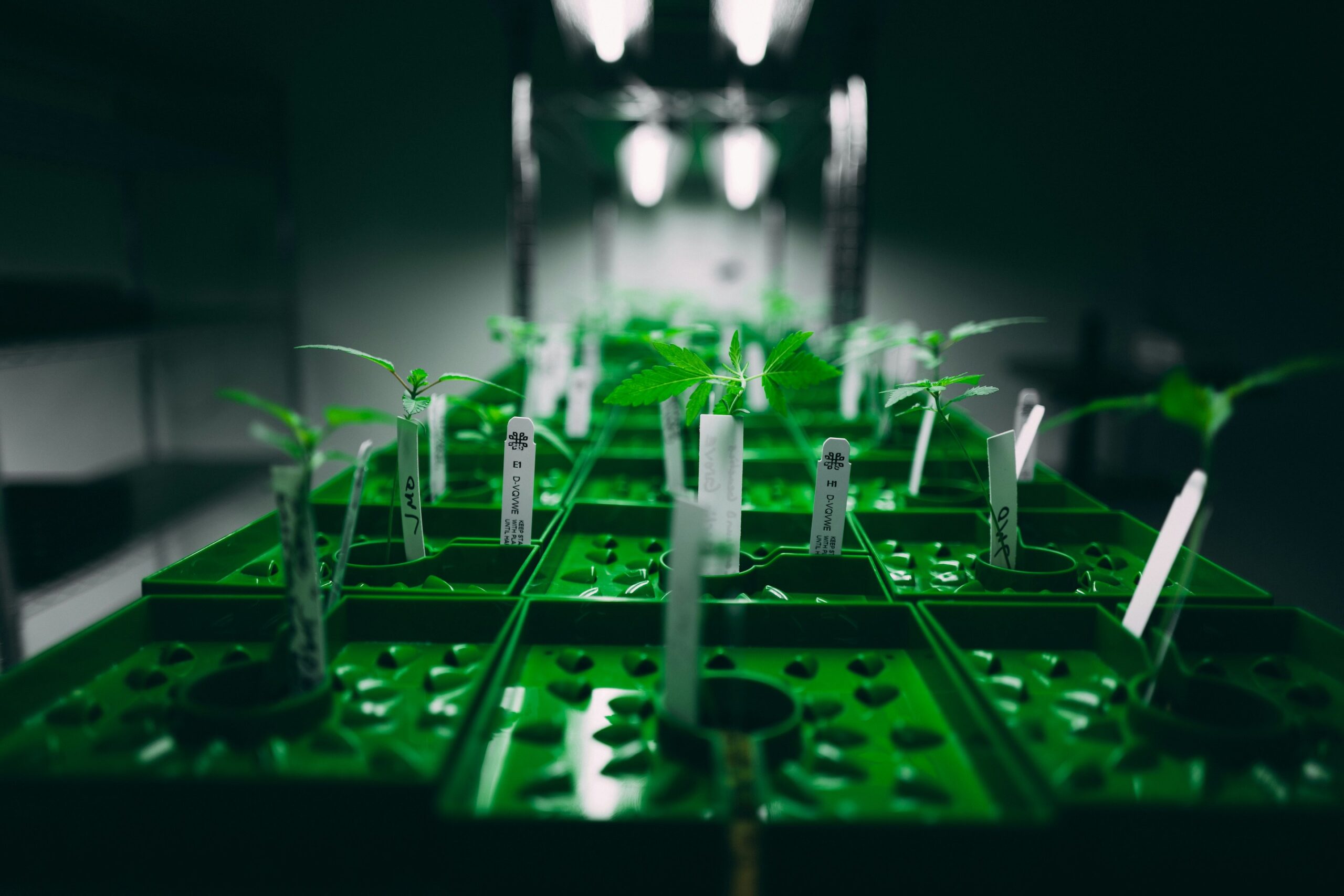
Weekly Cannabis News
July 29th – August 5th, 2022
Cannabis Use to Treat Perimenopause and Postmenopause Symptoms: Results from Survey
86.1% of participants reported using cannabis, with 78.7% to treat menopausal-related symptoms.
There are 3 types of menopauses usually occurring as a function of increasing age: perimenopause or menopause transition, menopause, and postmenopause. Menopause is defined as the permanent cessation of menstruation which is not associated with a disease or any type of medical treatment for 12 consecutive months, occurring in women approximately 50 years of age. [1] Along with hormonal changes (fluctuations in estrogen and progesterone levels), perimenopausal, menopausal, and postmenopausal women may also experience hot flashes and sweats, which are the most common problems, and can lead to sleep disturbance. [2] Other symptoms include changes in the membranes lining the vagina, joints soreness and stiffness as well as mood swings, anxiety and are at high risk of developing depressive episodes.[3],[4] Although several treatments are effective (e.g., estrogen replacement therapy, estrogen creams, low dose of selective serotonin reuptake inhibitors (SSRIs)), there is a need to investigate other therapeutic agents that can not only help relieving associated symptoms but also reduce the occurrence of side effects. [5],[6],[7]
The endocannabinoid system (ECS) is a wide-ranging biochemical communication and regulatory system that is primarily found in the central nervous system or CNS (consisting of the brain and spinal cord) and the peripheral nervous system or PNS (encompassing nerves outside the brain and spinal cord) as well as in the immune system. It regulates a variety of functions including sleep, mood, memory, appetite, pain sensation, and reproduction. [8] As such, it is not surprising that elements of the ECS such as the cannabinoid receptors 1 and 2 (CB1R and CB2R) and endocannabinoids are expressed in various tissues of the female reproductive organs including the ovaries, endometrium, and myometrium. [9] A few studies have shown that administration of cannabinoids and endocannabinoids can help in reducing anxiety or induce vasorelaxation, and such may offer promises in alleviate some of the most common symptoms observed in menopausal women. [10],[11] Despite the increasing use and the therapeutic promises that cannabis-based products may hold, there is a lack of studies investigating its potential benefits in relieving menopausal-associated symptoms.
A recent report by Dahlgreen et al., used surveys to assess some of the specifics behind their current reported medical cannabis use during perimenopause (n=131) and postmenopause (n=127). [12] These included modes of use, type of use, and menopause-related symptoms. Firstly, 86.1% of participants reported using cannabis, with 78.7% being to treat menopausal-related symptoms. Secondly, the most common routes of cannabis administration were via smoking and edibles and were used to treat sleep disturbance and to help with mood/anxiety. Compared to postmenopausal women, perimenopausal participants reported higher incidence of depression and hot flash, as well as increased use of medical cannabis products.
The authors concluded: “The current study indicates that many individuals are currently using commercially available MC products as an adjunct treatment for menopause-related symptoms via a variety of different modes of use…Overall, future research should continue to examine MC use for menopause-related symptoms, including assessing how unique cannabinoid profiles, modes of use, and other MC use characteristics impact safety and efficacy.”
Cannabidiol (CBD) & Anxiety Disorders
CBD decreased anxiety and depression-like symptoms and was a well-tolerated agent to treat anxiety disorders that needs further attention.
According to the American Psychological Association, anxiety is an emotion characterized by feelings of tension, worried thoughts, and physical changes like increased blood pressure. [13] It is the most common mental disorder in the US, affecting 40 million adults aged 18 or older, so about 19.1% of the population, with women are most likely to experience anxiety like symptoms compared to men. [14] While experiencing occasional anxiety is part of our lives as the body’s natural response to stress and may help with energy and boost or focus, repeated anxiety episodes can lead to intense, excessive, and persistent worry and fear that can interfere with daily activities. These repeated emotions are called anxiety disorders. These are among the most common mental disorders in young individuals, with a lifetime prevalence of 15%-20%. [15] A s of today, there are several non-pharmacological (e.g., cognitive behavioral therapy) and pharmacological (selective serotonin reuptake inhibitors (SSRIs)) approaches to help treat anxiety disorders. [16],[17] However, these can be ineffective and associated with unwanted side effects with increasing risks of remission. As such, there is a need to study alternative therapeutic options.
One strategic avenue that is gaining increasing popularity is the use of cannabis, and more specifically cannabidiol (CBD), the major non-psychoactive phytocannabinoid in the plant, whose role in improving symptoms of psychosis and treatment-refractory childhood epilepsies have been characterized. [18],[19] Specific to anxiety, CBD has been shown to reduce anxiety severity in case reports and in small randomized-controlled trial, but additional studies are needed to fully characterize its potential in anxiety disorders. [20],[21]
A group of researchers in Melbourne, Australia, aimed to investigate the safety and efficacy to CBD for 12 weeks as an adjunctive therapy in 31 young individuals with anxiety disorders who did not respond to standard treatment. [22] Overall, results indicated improvement in scales assessing anxiety and depression with no major events being reported. Some of the study limitations mentioned by the authors included the format of the open-label and uncontrolled trial in which causal influence about the efficacy of CBD relative to other influences is difficult to assess as well as including only a treatment-resistant population which may increase bias.
The authors concluded: “These findings suggest that CBD can reduce anxiety severity and has an adequate safety profile in young people with treatment-resistant anxiety disorders… To our knowledge, this clinical trial of CBD is the first in young people with anxiety disorders for whom established treatments are not effective. The findings of this trial suggest that further investigation of CBD for anxiety in conjunction with usual care is warranted…”
Cannabigerol (CBG) Alone or in Combination with Cannabidiol (CBD) to Treat Neuropathic Pain
Study results showed that CBG alone or with CBD was able alleviate cisplatin-induced peripheral neuropathy but failed to relieve persistent or thermal nociception.
The International Association for the Study of Pain (IASP) defines neuropathic pain as pain that arises as a direct consequence of a lesion or diseases affecting the somatosensory system. [23] Associated symptoms include allodynia (i.e., pain experienced despite no obvious cause for pain), burning pain, or electrical-like sensations are often chronic and lead to poor quality of life. Pharmacological interventions via the use of non-steroidal anti-inflammatory drugs (NSAIDs) or opioids have often limited efficacy and are associated with side effects. [24] As such, there is a need to focus on attention towards novel treatment options.
The cannabis plant contains more than 500 known compounds including phytocannabinoids, terpenes and flavonoids. As opposed to endocannabinoids which are synthesized in the human body, phytocannabinoids are produced in the glandular trichome of female flowers and are in part responsible for the effects one may feel when consuming the plant. There are as many as 113 different phytocannabinoids including cannabidiol (CBD) and ∆9-tetrahydrocannabinol (∆9-THC) which are the most used and studied. However, other understudied phytocannabinoids such as cannabinol (CBN) or cannabigerol (CBG) are gaining attention. CBG is synthesized from the “mother of all cannabinoids” called cannabigerol acid (CBGA) when exposed to heat via smoking or baking at specific temperature. [25] It is usually most abundant low ∆9-THC and high CBD cannabis strains. CBG is weak agonist of cannabinoid receptor 1 (CB1R) and a partial agonist of cannabinoid receptor 2 (CB2R). [26] Studies have shown that CBD alone or in combination with other phytocannabinoids can reduce pain and inflammation while maintaining a low safety profile. [27],[28] However, additional studies are needed to determine whether pure CBG or in combination with other phytocannabinoids can help decrease neuropathic pain.
A study by Sepulveda et al., aimed to investigate the potential anti-nociceptive effects of CBG alone or in combination with CBD in mice using three different models of pain to target various types of pain (e.g., cisplatin-induced peripheral neuropathy, the formalin test, and the tail-flick assay).[29] Overall, the group found that CBG alone or in with CBD was able to reduce mechanical hypersensitivity evoked by cisplatin-induced peripheral neuropathy but was ineffective at reducing pain in models of persistent or thermal nociception, suggesting the effects may be dependent on the type of pain.
The authors concluded: “We demonstrate that CBG (cannabigerol) and CBG: CBD oil attenuate neuropathy-induced mechanical hypersensitivity mice… These findings suggest that CBG metabolites may also generate anti-nociceptive effects in neuropathic mice. To date, there are no known reports that have investigated in vivo mammalian metabolism of CBG. Future research addressing this knowledge gap could have profound effects on pain modalities implemented clinically.”
Brittney Griner Sentenced to 9 Years in Prison
Her lawyers will appeal as they are surprised, disappointed, and not in line with the decision.
On February 17th, 2022, WNBA star Brittney Griner was detained in a Russian airport for carrying cannabis vape cartridges and was arrested on drug possession charges. [30] Recently, Briner pleaded guilty and could face up to 10 years in prison in Russia.
The sentence was given on Thursday August 4th, and she was sentenced to nine years in prison along with a 16 000$ fine. Few moments following the verdict, President Biden released the following statement: “Today, American citizen Brittney Griner received a prison sentence that is one more reminder of what the world already knew: Russia is wrongfully detaining Brittney…It’s unacceptable, and I call on Russia to release her immediately so she can be with her wife, loved ones, friends, and teammates.” [31] He hopes to work diligently to bring her back to the US.
At the hearing, Briner said: “I want the court to understand that this was an honest mistake that I made while rushing, under stress, trying to recover from COVID and just trying to get back to my team… I made an honest mistake and I hope that in your ruling, that it doesn’t end my life here.” [32]
Her lawyers will appeal as they do not agree with the decision made by the court.
References:
[1] https://www.mayoclinic.org/diseases-conditions/menopause/symptoms-causes/syc-20353397, assessed on August 5th, 2022
[2] Monteleone P, Mascagni G, Giannini A, Genazzani AR, Simoncini T. Symptoms of menopause – global prevalence, physiology and implications. Nat Rev Endocrinol 2018;14(4):199-215. DOI: 10.1038/nrendo.2017.180.
[3] Bromberger JT, Matthews KA, Schott LL, et al. Depressive symptoms during the menopausal transition: the Study of Women’s Health Across the Nation (SWAN). J Affect Disord 2007;103(1-3):267-72. DOI: 10.1016/j.jad.2007.01.034.
[4] Santoro N, Epperson CN, Mathews SB. Menopausal Symptoms and Their Management. Endocrinol Metab Clin North Am 2015;44(3):497-515. DOI: 10.1016/j.ecl.2015.05.001.
[5] Fait T. Menopause hormone therapy: latest developments and clinical practice. Drugs Context 2019;8:212551. DOI: 10.7573/dic.212551.
[6]Paraiso MFR, Ferrando CA, Sokol ER, et al. A randomized clinical trial comparing vaginal laser therapy to vaginal estrogen therapy in women with genitourinary syndrome of menopause: The VeLVET Trial. Menopause 2020;27(1):50-56. DOI: 10.1097/GME.0000000000001416.
[7] Rahimzadeh P, Imani F, Nafissi N, Ebrahimi B, Faiz SHR. Comparison of the effects of stellate ganglion block and paroxetine on hot flashes and sleep disturbance in breast cancer survivors. Cancer Manag Res 2018;10:4831-4837. DOI: 10.2147/CMAR.S173511.
[8] Meccariello R. Endocannabinoid System in Health and Disease: Current Situation and Future Perspectives. Int J Mol Sci 2020;21(10). DOI: 10.3390/ijms21103549.
[9] El-Talatini MR, Taylor AH, Elson JC, Brown L, Davidson AC, Konje JC. Localisation and function of the endocannabinoid system in the human ovary. PLoS One 2009;4(2):e4579. DOI: 10.1371/journal.pone.0004579.
[10] Szabo R, Borzsei D, Szabo Z, et al. A Potential Involvement of Anandamide in the Modulation of HO/NOS Systems: Women, Menopause, and “Medical Cannabinoids”. Int J Mol Sci 2020;21(22). DOI: 10.3390/ijms21228801.
[11] Stanley C, O’Sullivan SE. Vascular targets for cannabinoids: animal and human studies. Br J Pharmacol 2014;171(6):1361-78. DOI: 10.1111/bph.12560.
[12] Dahlgren MK, El-Abboud C, Lambros AM, Sagar KA, Smith RT, Gruber SA. A survey of medical cannabis use during perimenopause and postmenopause. Menopause 2022. DOI: 10.1097/GME.0000000000002018.
[13]https://www.apa.org/topics/anxiety#:~:text=Anxiety%20is%20an%20emotion%20characterized,certain%20situations%20out%20of%20worry., assessed on August 5th, 2022
[14] https://adaa.org/understanding-anxiety/facts-statistics, assessed on August 5th, 2022
[15] Beesdo K, Knappe S, Pine DS. Anxiety and anxiety disorders in children and adolescents: developmental issues and implications for DSM-V. Psychiatr Clin North Am 2009;32(3):483-524. DOI: 10.1016/j.psc.2009.06.002.
[16] Cuijpers P, Cristea IA, Karyotaki E, Reijnders M, Huibers MJ. How effective are cognitive behavior therapies for major depression and anxiety disorders? A meta-analytic update of the evidence. World Psychiatry 2016;15(3):245-258. DOI: 10.1002/wps.20346.
[17] Dobson ET, Bloch MH, Strawn JR. Efficacy and Tolerability of Pharmacotherapy for Pediatric Anxiety Disorders: A Network Meta-Analysis. J Clin Psychiatry 2019;80(1). DOI: 10.4088/JCP.17r12064.
[18] McGuire P, Robson P, Cubala WJ, et al. Cannabidiol (CBD) as an Adjunctive Therapy in Schizophrenia: A Multicenter Randomized Controlled Trial. Am J Psychiatry 2018;175(3):225-231. DOI: 10.1176/appi.ajp.2017.17030325.
[19] Devinsky O, Cross JH, Laux L, et al. Trial of Cannabidiol for Drug-Resistant Seizures in the Dravet Syndrome. N Engl J Med 2017;376(21):2011-2020. DOI: 10.1056/NEJMoa1611618.
[20] Shannon S, Lewis N, Lee H, Hughes S. Cannabidiol in Anxiety and Sleep: A Large Case Series. Perm J 2019;23:18-041. DOI: 10.7812/TPP/18-041.
[21] Masataka N. Anxiolytic Effects of Repeated Cannabidiol Treatment in Teenagers With Social Anxiety Disorders. Front Psychol 2019;10:2466. DOI: 10.3389/fpsyg.2019.02466.
[22] Berger M, Li E, Rice S, et al. Cannabidiol for Treatment-Resistant Anxiety Disorders in Young People: An Open-Label Trial. J Clin Psychiatry 2022;83(5). DOI: 10.4088/JCP.21m14130.
[23] https://www.iasp-pain.org/advocacy/global-year/neuropathic-pain/, assessed on August 5th, 2022
[24] Maihofner C, Diel I, Tesch H, Quandel T, Baron R. Chemotherapy-induced peripheral neuropathy (CIPN): current therapies and topical treatment option with high-concentration capsaicin. Support Care Cancer 2021;29(8):4223-4238. DOI: 10.1007/s00520-021-06042-x.
[25] Wang M, Wang YH, Avula B, et al. Decarboxylation Study of Acidic Cannabinoids: A Novel Approach Using Ultra-High-Performance Supercritical Fluid Chromatography/Photodiode Array-Mass Spectrometry. Cannabis Cannabinoid Res 2016;1(1):262-271. DOI: 10.1089/can.2016.0020.
[26] Navarro G, Varani K, Reyes-Resina I, et al. Cannabigerol Action at Cannabinoid CB1 and CB2 Receptors and at CB1-CB2 Heteroreceptor Complexes. Front Pharmacol 2018;9:632. DOI: 10.3389/fphar.2018.00632.
[27] De Gregorio D, McLaughlin RJ, Posa L, et al. Cannabidiol modulates serotonergic transmission and reverses both allodynia and anxiety-like behavior in a model of neuropathic pain. Pain 2019;160(1):136-150. DOI: 10.1097/j.pain.0000000000001386.
[28] Deiana, S. (2017). Chapter 99 –Potential medical uses of Cannabigerol: A brief overview. In Handbook of cannabis and related pathologies (pp. 958–967). Academic Press
[29] Sepulveda DE, Morris DP, Raup-Konsavage WM, Sun D, Vrana KE, Graziane NM. Cannabigerol (CBG) attenuates mechanical hypersensitivity elicited by chemotherapy-induced peripheral neuropathy. Eur J Pain 2022. DOI: 10.1002/ejp.2016.
[30] https://www.nytimes.com/2022/03/05/sports/basketball/russia-brittney-griner.html, assessed on August 5th, 2022
[31] https://www.whitehouse.gov/briefing-room/statements-releases/2022/08/04/statement-by-president-joe-biden-on-the-sentencing-of-wrongfully-detained-american-brittney-griner/#:~:text=Today%2C%20American%20citizen%20Brittney%20Griner,ones%2C%20friends%2C%20and%20teammates, assessed on August 5th, 2022
[32] https://www.nytimes.com/2022/08/04/world/europe/brittney-griner-trial-testimony.html, assessed on August 5th, 2022






